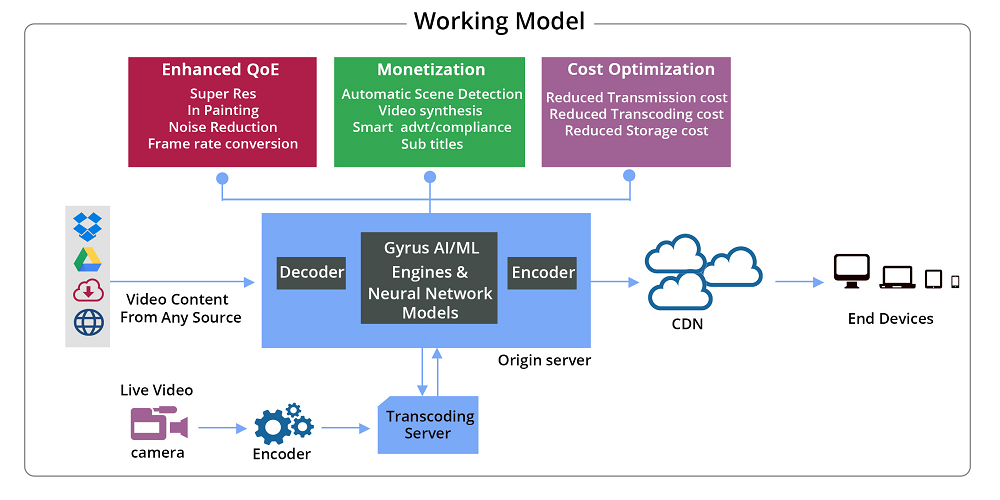

Gyrus AI leverages AI, ML & Neural Network to solve video streaming challenges such as poor video quality, low resolutions, buffering issues, high CDN operating cost, etc, by providing the highest possible quality of experience (QoE) and quality of service (QoS). A single neural network can be trained to do upscaling with higher PSNR, Noise reduction, Remove watermarks & repair damaged video. A machine learning engine can be used to optimize the encoding parameters dynamically in OTT streaming to increase QoE and optimize CDN operating costs. Gyrus AI uses Automatic scene detection & video synthesis models for smart advertisements, complying with regulatory warnings, generating subtitles at high speeds, and providing video analytics to improve viewer engagement. Every one of our AI models allows for a great deal of customizability enabling our customers to tailor them to their requirements.

AI/ML Engines Video Streaming workflow
Gyrus AI leverages expertise in AI & ML to develop customized models for most demanding applications in the video processing domain. The video processing AI/ML models can be deployed either on-premises broadcasting/streaming devices or in cloud-based streaming platforms. The AI models can also be customized and ported to various end devices. Gyrus AI’s video processing models are independent of encoder specs. The Video processing AI models help to reduce complex work on the compression side and improve quality by applying adaptive filtering at a decoded picture. This will help to enhance video quality and thus provide QoE and QoS. Gyrus ML engines can be deployed on the server-side to provide optimal transcoding parameters and to reduce CDN operating costs.

Every frame/scene can be classified for detection of Specific objects, location, action & Face recognition of the character. Gyrus AI/ML engine can understand the context of the scene. Based on the object, action, and context, the customized advertisement & Auto captions for regulatory warnings can be inserted. This model can create a searchable table of content and helps in auto classifications of the nudity, auto-captions, etc.

Video Streaming Devices with AI/ML engines outperform with enhanced streaming quality, Intelligent video experience, and ease of use with personalization. Gyrus AI/ML models can provide solutions for Improving the quality of an image, removing watermarks and damages from the image, noise reduction, Frame rate conversion, etc. A single neural network can be trained to Super Resolution, Inpainting & noise reduction.

It is a technique that enhances the quality of a given low- resolution images/video to high resolution by upscaling. Scaling with Neural Network is more efficient and improves resolution than bilinear and bicubic scaling. The super-resolution model produces resolutions that are 2-4 times higher than the pixel count of the sensor better PSNR. Normally traditional scaling blurs the edges, whereas neural network-based scaling keeps the sharp edges.

Style transfer of one image to another image can be performed very efficiently using AI models. In addition, Synthetic data can be created and embedded along with the broadcast content seamlessly by AI engines. The synthesized video can for example generate custom textures, messages, logos, within an active scene without disrupting the flow. A new advertisement can replace the existing banner ad within the scene without any human involvement.

Gyrus ML Engine can be deployed to optimize the encoding parameters dynamically. This not only increases user QoE and QoS but also reduces the number of bits required for the required quality. Encoding optimization using machine learning can also help optimize costs in the form of less bandwidth usage, storage costs, etc. Neural networks (NN) dynamically predict the video encode quantization levels (QL) that can produce target bitrate and achieve the performance of dual-pass encoding in a single pass. As a result, it will also reduce overall video latency and encoding costs.

Compliance often requires the content provider to identify events/scenes in a video that may be restricted in specific territories. AI engines identify such scenes and present “time-in” and “time-out” points to an editing system to perform edits. Moreover, AI can quickly flag objectionable content and helps comply with regulatory requirements and prevent snafus. The commercial compliance requirements (logo colors/dimensions) take quite a lot of manual checks and clean up. AI/ML engines can perform these tasks very effectively.
Visit the Demo page